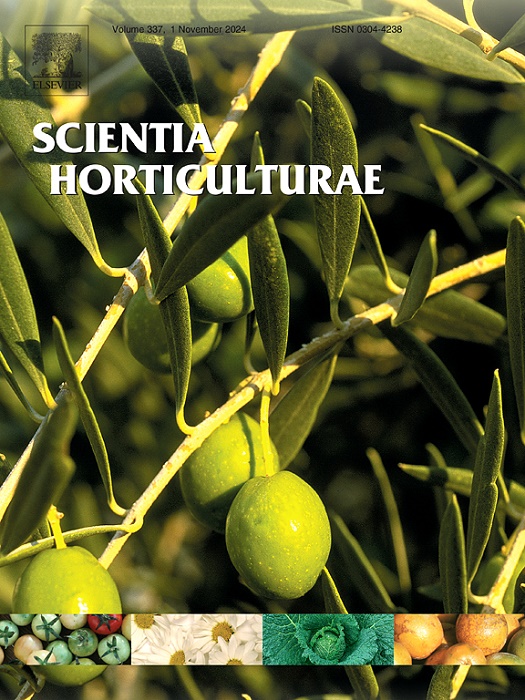Exploring changes in texture, colour, pungency and storability in diverse chilli genotypes for discriminating behaviour beyond harvest
IF 3.9
2区 农林科学
Q1 HORTICULTURE
引用次数: 0
Abstract
In this study, postharvest behavioural dynamics among 52 diverse chilli genotypes was observed during storage (15°C) to discriminate and cluster them in accordance to their inherent responses. Fruit weight, size, weight loss, colour change, firmness, capsaicin, chlorophyll, carotenoids (red and yellow fractions), moisture content and purchase preference were recorded. Significant differences were observed among genotypes. A2 x IIVRC 18057 and IIVRC 18093 registered minimum (24.4 %) and maximum (71.7 %) weight loss, respectively at the end of storage. In all genotypes, moisture content declined with storage. Genotype dependent inverse relationship between capsaicin content at green and red stage was observed (r= -0.51). Firmness ranged between highest (4.65 N) in IIVRC 22100 on day zero, to lowest (0.14 N) in A3 x F5–112 on day 10. IIVRC 18131, Kashi Surkh, and IIVRC 18160 showed higher firmness. The loss of smooth glossy appearance, colour change and carotenoids accumulation showed variable responses during storage. Minimum colour changes were observed in IC119455, IC114957, IC119326, IC119327, EC 578666, IIVRC 18093, IIVRC 23002 and IIVRC 20005. Chlorophyll ranged between 68.63 µg/g fw (Pusa Jwala) to 270.61 µg/g fw (Kashi Gaurav) initially. Chemometric analysis using clustering and principal component analysis was performed. IIVRC 18093 and IIVRC 18253 were found most distant and can be utilized in breeding. IIVRC 18057 clearly indicated consumer liking in preference ranking test over other genotypes on final day. Overall, inherent diversity pointed the potential for careful selection of specific genotypes for definite breeding, consumer acceptability, marketing and storability strategies.
探索不同辣椒基因型在质地、颜色、辛辣味和贮藏性方面的变化,以鉴别收获后的表现形式
本研究观察了 52 种不同辣椒基因型在贮藏(15°C)期间的采后行为动态,以根据其固有反应对其进行区分和分类。记录了果实重量、大小、重量损失、颜色变化、硬度、辣椒素、叶绿素、类胡萝卜素(红色和黄色部分)、水分含量和购买偏好。不同基因型之间存在显著差异。A2 x IIVRC 18057 和 IIVRC 18093 在贮藏结束时的重量损失分别最小(24.4%)和最大(71.7%)。所有基因型的水分含量都随着贮藏时间的延长而下降。在绿色和红色阶段,辣椒素含量与基因型呈反比关系(r= -0.51)。坚硬度介于第 0 天最高(4.65 N)的 IIVRC 22100 和第 10 天最低(0.14 N)的 A3 x F5-112 之间。IIVRC 18131、Kashi Surkh 和 IIVRC 18160 的坚实度较高。在贮藏过程中,平滑光泽的丧失、颜色的变化和类胡萝卜素的积累表现出不同的反应。在 IC119455、IC114957、IC119326、IC119327、EC 578666、IIVRC 18093、IIVRC 23002 和 IIVRC 20005 中观察到的颜色变化最小。叶绿素最初介于 68.63 µg/g fw(Pusa Jwala)到 270.61 µg/g fw(Kashi Gaurav)之间。采用聚类和主成分分析法进行了化学计量分析。发现 IIVRC 18093 和 IIVRC 18253 的距离最远,可用于育种。在最后一天的偏好排序测试中,IIVRC 18057 比其他基因型更受消费者青睐。总之,固有的多样性表明,有可能为明确的育种、消费者接受度、营销和贮藏策略而仔细选择特定的基因型。
本文章由计算机程序翻译,如有差异,请以英文原文为准。
求助全文
约1分钟内获得全文
求助全文
来源期刊

Scientia Horticulturae
农林科学-园艺
CiteScore
8.60
自引率
4.70%
发文量
796
审稿时长
47 days
期刊介绍:
Scientia Horticulturae is an international journal publishing research related to horticultural crops. Articles in the journal deal with open or protected production of vegetables, fruits, edible fungi and ornamentals under temperate, subtropical and tropical conditions. Papers in related areas (biochemistry, micropropagation, soil science, plant breeding, plant physiology, phytopathology, etc.) are considered, if they contain information of direct significance to horticulture. Papers on the technical aspects of horticulture (engineering, crop processing, storage, transport etc.) are accepted for publication only if they relate directly to the living product. In the case of plantation crops, those yielding a product that may be used fresh (e.g. tropical vegetables, citrus, bananas, and other fruits) will be considered, while those papers describing the processing of the product (e.g. rubber, tobacco, and quinine) will not. The scope of the journal includes all horticultural crops but does not include speciality crops such as, medicinal crops or forestry crops, such as bamboo. Basic molecular studies without any direct application in horticulture will not be considered for this journal.
 求助内容:
求助内容: 应助结果提醒方式:
应助结果提醒方式:


